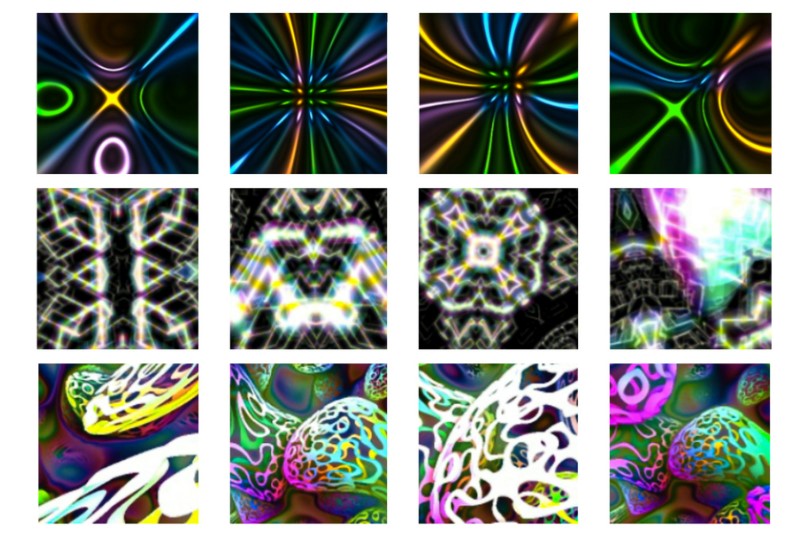New research reveals a scalable technique that uses synthetic data to improve the accuracy of AI models that recognize images.
Copyright: news.mit.edu – “A simpler path to better computer vision”
 Researchers used a large collection of simple, uncurated synthetic image generation programs to pretrain a computer vision model for image classification. The researchers didn’t curate or alter the programs, which each comprised just a few lines of code. In this image, the image sets in each row were produced using 3 different image generation programs.
Researchers used a large collection of simple, uncurated synthetic image generation programs to pretrain a computer vision model for image classification. The researchers didn’t curate or alter the programs, which each comprised just a few lines of code. In this image, the image sets in each row were produced using 3 different image generation programs.
Before a machine-learning model can complete a task, such as identifying cancer in medical images, the model must be trained. Training image classification models typically involves showing the model millions of example images gathered into a massive dataset.
However, using real image data can raise practical and ethical concerns: The images could run afoul of copyright laws, violate people’s privacy, or be biased against a certain racial or ethnic group. To avoid these pitfalls, researchers can use image generation programs to create synthetic data for model training. But these techniques are limited because expert knowledge is often needed to hand-design an image generation program that can create effective training data.
Researchers from MIT, the MIT-IBM Watson AI Lab, and elsewhere took a different approach. Instead of designing customized image generation programs for a particular training task, they gathered a dataset of 21,000 publicly available programs from the internet. Then they used this large collection of basic image generation programs to train a computer vision model.
These programs produce diverse images that display simple colors and textures. The researchers didn’t curate or alter the programs, which each comprised just a few lines of code.
Thank you for reading this post, don't forget to subscribe to our AI NAVIGATOR!
The models they trained with this large dataset of programs classified images more accurately than other synthetically trained models. And, while their models underperformed those trained with real data, the researchers showed that increasing the number of image programs in the dataset also increased model performance, revealing a path to attaining higher accuracy.[…]
Read more: www.news.mit.edu


New research reveals a scalable technique that uses synthetic data to improve the accuracy of AI models that recognize images.
Copyright: news.mit.edu – “A simpler path to better computer vision”
Before a machine-learning model can complete a task, such as identifying cancer in medical images, the model must be trained. Training image classification models typically involves showing the model millions of example images gathered into a massive dataset.
However, using real image data can raise practical and ethical concerns: The images could run afoul of copyright laws, violate people’s privacy, or be biased against a certain racial or ethnic group. To avoid these pitfalls, researchers can use image generation programs to create synthetic data for model training. But these techniques are limited because expert knowledge is often needed to hand-design an image generation program that can create effective training data.
Researchers from MIT, the MIT-IBM Watson AI Lab, and elsewhere took a different approach. Instead of designing customized image generation programs for a particular training task, they gathered a dataset of 21,000 publicly available programs from the internet. Then they used this large collection of basic image generation programs to train a computer vision model.
These programs produce diverse images that display simple colors and textures. The researchers didn’t curate or alter the programs, which each comprised just a few lines of code.
Thank you for reading this post, don't forget to subscribe to our AI NAVIGATOR!
The models they trained with this large dataset of programs classified images more accurately than other synthetically trained models. And, while their models underperformed those trained with real data, the researchers showed that increasing the number of image programs in the dataset also increased model performance, revealing a path to attaining higher accuracy.[…]
Read more: www.news.mit.edu
Share this: